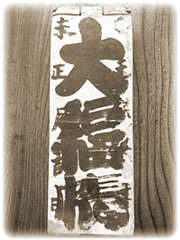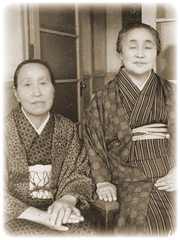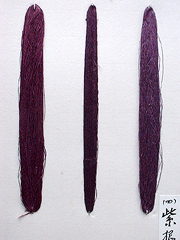泉金ホールディングスのはじまり

安政元年(1854年)黒船来航で江戸が騒がしくなっている頃、遠く離れた南部藩(現在の岩手県)岩泉の八重樫家では、日本酒の初搾りが試みられました。初代八重樫長吉から数えて5代目喜太郎のときです。
岩泉の人々は自然環境と共に歩んできました。特に、豊富な木材資源を利用した薪炭の生産は古くから金、銅の精錬や製鉄のために盛んに行われていました。安政4年(1857年)釜石で日本初の洋式高炉による近代製鉄が始まったとき、燃料は木炭でした。
初代八重樫金十郎・リウ

初代八重樫金十郎とリウ
1868年、明治の幕開けとともに、進取の気性にあふれた岩泉の先人たちは新しい産業に取り組みました。6代目となる八重樫金十郎もその一人でした。
明治4年、岩泉には、日本に輸入されたばかりの牛の2頭(ショートホーン種)が貸与され、南部牛の交配も行われました。もともと沿岸の海産物や粗鋼を運ぶルートに位置していたため、民謡「南部牛追い唄」に代表されるように、藩制時代から牛による運送や畜産が盛んでした。
ところが、6代金十郎(襲名初代)が家督を継いだころ、明治16年(1883年)岩泉は大火に見舞われ、街の中心部は大きな被害を受けました。泉金ホールディングスも例外ではありませんでした。
家業を再建するために、現在の場所に蔵と住居を新築、当時の梁や柱は今も健在です。また、蔵の位置は防火壁としての機能も備え、防災の観点からも考慮されています。
明治23年(1890年)「八重桜」という銘柄で売り出すに至りました。
初代金十郎は醸造業のに加え、林業、養蚕業で地域振興を目指しました。たびたび冷害に見舞われ、不作に苦しめられたことから、中野地区の開墾に力を注ぎました。その結果、多くの人々が稲作に従事するようになりました。同時に、東京の動きをいち早く取り入れ、経済活動に生かしました。
妻のリウは篤志家として知られ、私財を投じて明治16年の大火で焼失した菩提寺、雲岩寺の再興に努め、中興開基に任ぜられました。また、紫根染めの技法を伝承し、その保存に努めました。民芸運動の創始者、柳宋悦が訪れた際、染色技法を披露しました。
大勢の使用人をまとめる厳格な女傑だった半面、恵まれない子供たちを養育する福祉活動にも熱心でした。
二代目八重樫金十郎・フジ

二代目八重樫金十郎
2代目金十郎はさらに経済基盤を発展させるべく、地域の産業振興に心血を注ぎました。県央部との交通の重要性を認識、当時珍しかった自動車を導入、本格的に運送業を始めました。水力発電所建設や岩泉線の開通に尽力しました。また、岩泉を盛岡を結ぶ道路の開通にも奔走しました。町内に電気の明かりがついたのが大正8年(1919年)ですから、県内でも盛岡に次ぐ早さでした。
ただ、昭和の恐慌や繭価の暴落、三陸大津波、そして、終戦と数々の困難を乗り越えなければなりませんでした。

八重樫フジ(右側)
妻のフジは姑のリウから紫根染めの手ほどきを受け、岩手県の無形文化財保持者に認定されました。正月に始まる数々の節句行事、田植え、味噌・醤油の自家製造、養蚕、稲刈り等で一年中忙しく過ごしました。フジにおいても社会奉仕の気持ちは強く、親を亡くした子供たちの支援や地元の女性に働く機会を与えることで地域社会に貢献しました。
紫根染めについて

藩制時代より八重樫家にはムラサキ草の根(紫根)を使用した糸染めが伝承されています。当時、養蚕が盛んだったこともあり、染められた糸は、機で織られ、反物として着物地や布団地に仕立てられました。物資が豊かでなかった頃、それは嫁入り道具や来訪者のお土産となりました。
また、高貴な紫根染めの品は、幕府へ、明治以降では皇室への献上品としての栄誉を賜りました。
良質の紫の糸を染めるためには、妥協なく多くの過程をこなさなければなりません。
残念なことに、近年植生の変化で原料の日本ムラサキが絶滅の危機にあり、自生の紫根を集めるのは不可能になっています。
“Light up the place where you belong. Make the best effort possible and be honest.”
This is a long-treasured value of the Yaegashi family. The hometown,Iwaizumi,is situated in a remote area, surrounded by mountains which made business and farming difficult, people there lived a hard life. So the family has always cared for the quality of life the people in the town.
The beginning of Senkin brewery
In 1854, when US naval officer Commodore Perry appeared in Tokyo Bay, people were astonished to see the huge steaming black ships. At the same time, far from Tokyo, in Iwaizumi, the fifth generation of the Yaegashi, Kitaro, tried the first pressing of sake. He established a new brewery and started a sake brewing business.
In 1868, the new government was established; “the Meiji Restoration”, one of the greatest events in Japanese history changed the whole of Japan completely, not only the political system, but every aspect of life was changed. Even in a chaotic situation there was a positive atmosphere in Iwaizumi for getting into a new business.
Kinjuro Yaegashi Sr.
The eldest son, Kinjuro, the 6th generation of the Yaegashi, realized the importance of getting information from Tokyo to catch up with the rapid modernization of society. Since the feudal era, the Yaegashi family business had been based on the local environment, such as forestry(lumber and charcoal selling), agriculture(rice and other grain production), household handicraft industry (silk) and cattle raising.
To overcome the poor harvest caused by severe weather, he encouraged cultivating new rice paddy fields and establishing irrigation facilities which led to job opportunities for the people and raised productivity.
And he was engaged in the transportation business, too, using the advantage that Iwaizumi is an outpost along the route that connects the coast and Morioka, the capital city of Iwate, and beyond to Tokyo. In those days teams of oxen led by bullocky or ox-drivers were used to transport products from the coast, for example, sea weeds, salts or iron sand. Heavy loads were carried on the back of oxen, as in the famous folk song ”Nambu Ushi-Oi Uta”(Oxen Song in Nambu ) that depicts their travel on steep winding trail.
In 1883 a large fire devastated the whole town of Iwaizumi. In spite of disastrous surroundings Kinjuro Sr. decided to rebuild the family business. He moved to a new place to build a new brewery. Since then the wooden building has been in use and consists of brewing facilities and a residential area. Without using nails, beams and posts are interlocked, so it is earthquake resistant. For fireproofing they placed storehouses made of timber columns and clay on each side of the house.
7 years later, in 1890, the sake was finally sold under the brand name “Yaezakura”.
Riu Yaegashi- wife of Kinjuro
His wife “Riu” is said to have been a gutsy, hard-working woman with a strong will. She dedicated her life to supporting her husband and after her husband’s death, she showed strong leadership in organizing many employees and their families. Rebuilding the family temple, the burnt down “Un-Gan-ji”, is one of her endeavors. She still is respected as a “restorer”. Her voluntary work for orphaned children and providing job opportunities and foods for employees meant a social welfare in the days when there were few official supports for the people.
And she also had a technique for silk dyeing using Shikon roots which is handed down from generation to generation in the Yaegashi family. The main workers in the silk industry were women, from growing silk worm to reeling, spinning and weaving. She enjoyed her life and died at the age of 82.
Kinjuro Yaegashi Jr.
The 7th generation, Kinjuro Jr. had inherited businesses from his father and devoted his life to developing the local economy. He also was elected a member of the Iwate prefectural assembly. The largest concern for him was the economic disparity between the Iwaizumi region and central Iwate. He knew the importance of transportation connecting these two areas. So he introduced automobiles which were not popular at all at that time and started transporting goods by car, established a power station and convinced the assembly to establish a railway.
However, he had to overcome lots of difficulties during his life, such as the Showa Depression(1927), The Sanriku Tsunami (1933) and the defeat of the Second World War(1945).
Fuji Yaegashi- wife of Kinjuro Jr.
His wife, Fuji, was educated in Tokyo in her younger days, then she came back to Iwaizumi for marriage. She learned the dyeing method using Shikon from her mother in-law Riu, and was honored to be an Intangible Asset Holder in Iwate prefecture.She was very busy with household or family affairs, as she had to organize seasonal events, such as New Year’s Day celebrations, seasonal cleanings, Buddhist memorial events or get-togethers in the community. Events regarding rice harvest are especially important throughout the year. It starts with planting rice seedlings in the spring and ends with the harvest in fall. Products such as soy-sauce and miso were home-made by women and growing silk worms was also done by female workers. Fuji was warm-hearted and she also supported children who had lost their parents or were from the poor families.
The Shikon dyeing and the Yaegashi family
Since the feudal era, the Shikon dyeing technique has been handed down from generation to generation in the Yaegashi family. The dye used in Shikon dyeing is roots of the Murasaki (Lithospermum erythrorhizon or Purple Gromwell) plant. In the feudal era, the roots were submitted as a levy to the local rulers, for in the upland areas rice production is limited and the roots can also be used for medicine. Silk production was once a thriving industry; dyeing the skeins of thread played an important part in silk manufacturing. Articles dyed with Shikon were dedicated to the Shogun or the royal family as a token of gratitude or as a souvenir
These days environmental conditions are changing, the species itself is listed as an endangered IB species in the red data book. It has become impossible to collect indigenous plants or roots now.







